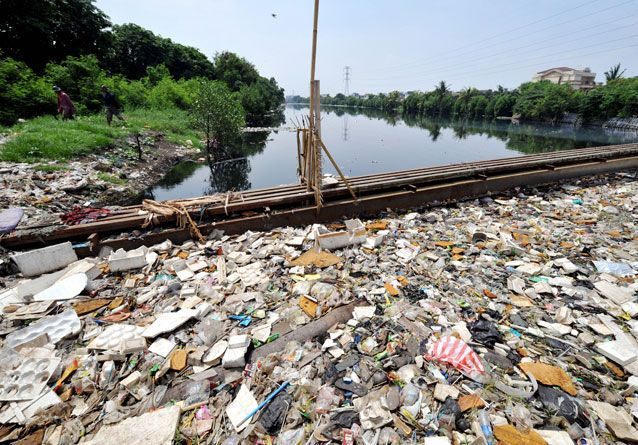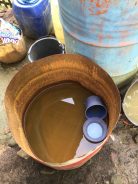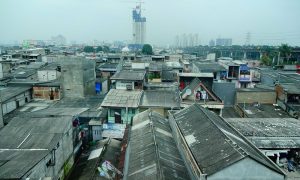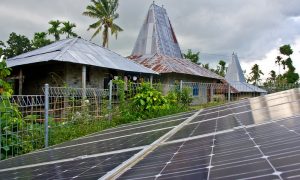Citarum River in West Java province is dubbed one of the dirtiest river in the world, and cleaning it up is an almost unmanageable job. The government has to deal with more than 3000 businesses along the river bank, with a large portion of them being multinationals. That excludes the tens of millions of households depending on water from the river. My research fieldwork, conducted in West Java from March to May 2022, attempted to verify what the authorities have applied to revitalise the river, and their types of relations. Apparently, massive financial and technological resources have been poured into the Citarum Watershed, including from overseas. Citarum is one of the most strategic rivers in Indonesia, and historically attractive for investors and foreign aid donors.
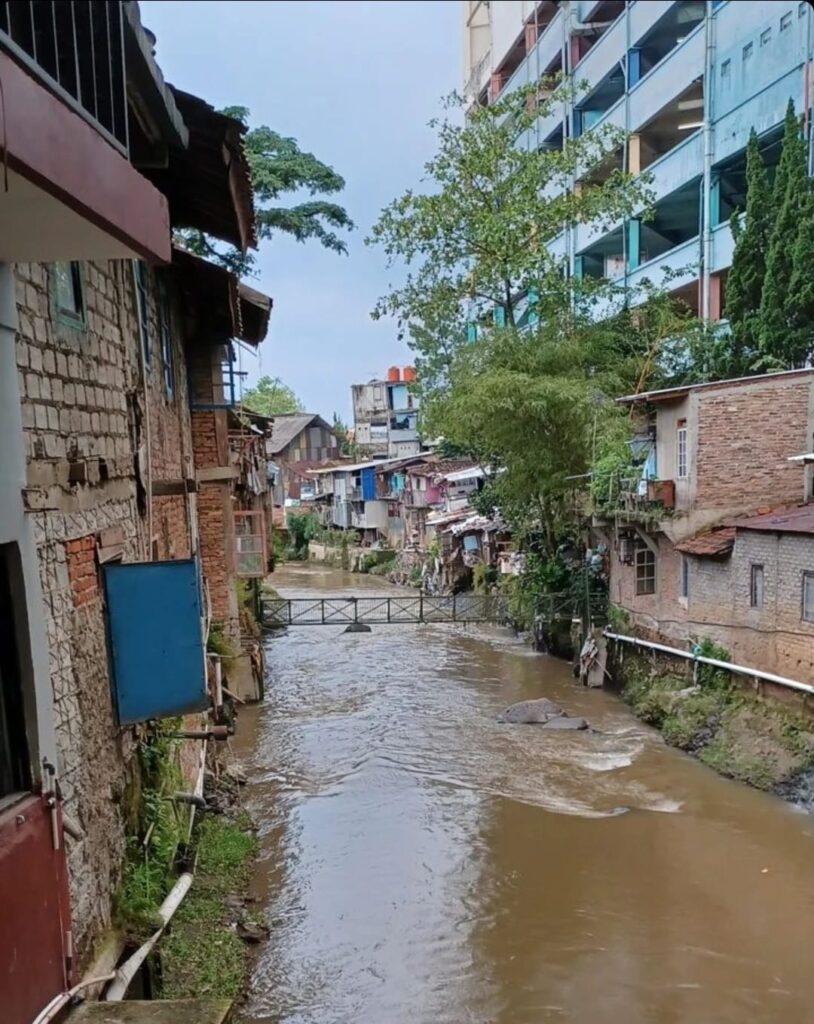
Cikapundung River in Bandung in March 2022. Image supplied by the author.
The armed forces, police, lawyers, and private businesses have been tasked with preventing the river from excessive pollution, and the mobilisation of scrutinising powers have created a situation where the river clean-up is politically motivated. Practices of subcontracting government aid projects are evident, as well as alleged collusion between district commandants and factory owners.
There are contending concepts of Citarum River between policy planners, the actors and their respective roles in the execution, and on the reframing of pollution management politics in the Citarum Watershed. My fieldwork followed Citarum sub-streams along Majalaya, Bojongsoang, Dayeuhkolot, City of Bandung, and City of Bekasi. The pollution level is more precarious mid-stream and downstream. As Citarum spans 297 kilometres, only very selective site visits and interviews were conducted.
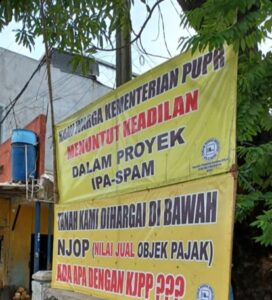
A protest banner in a local community opposing the Ministry of Public Works and Housing, which they claim has under compensated them for land transfer contracts for drinking water projects in Bekasi. March 2022. Image supplied by the author.
After President Joko Widodo issued Presidential Regulation no. 15 in 2018 on Acceleration of Pollution and Damage Control on Citarum Watershed, Special Task Force (Satgas PPK Citarum) was founded. Currently, there are 23 sectors of Citarum watershed, with each sector having a commandant, often called Dansektor (acronym of Komandan Sektor or Sectoral Commandant) from Military Command III Siliwangi in West Java. In an interview with one of the chiefs of the Task force in South Bandung, I was told there are different opinions about territorial divisions of Citarum for more effective execution. The government’s action plan sanctions greater discretion and observation of ecological features of the watershed. Nevertheless, the plan has repeatedly failed to come into force. This was due to lack of facilitators, lack of state expenditure, and relatively low bargaining power with business owners. Moreover, my source said that the original Presidential Regulation was legislated in a rush without proper academic reviews.
Military perspectives divided Citarum based on military territorial operations. From originally just a few, it has expanded into 23 areas, regardless of each of the sub-streams’ ecological function. River clean-up activities include regular garbage cleaning in the river with communities and NGOs, mainly based in “kelurahan” (villages). The military and police officers also inspect the waste management systems regularly, often with surprise visits. However, my observations show that one command post was located just outside the gate of a textile factory in Dayeuhkolot, raising a question about neutrality.
The right to water: governing private and communal provision in rural Indonesia
Three cases illustrate that the role of private providers and communal works, or a combination of the two, are the norm among poor, rural communities
About IDR 200 billion (approx. AUD 19,815,000) has been allocated for the armed forces from the budget of The Ministry of Public Works and Housing. A local environment activist commented that the military role was exaggerated. He implied that long before the military came, local environmental champions have been campaigning and working on the pollution issues. Moreover, he claimed that dispatching the army just meant more cost for the state instead of allocating the funds for civilian initiatives. However, according to a foreign project consultant, inviting the army into river rehabilitation program is one of the best decisions. It had not been done prior to 2018 and according to him, the army could expedite the clean-up to just a few years.
At UNFCCC COP 26 Summit in Glasgow, UK, Governor of West Java, Ridwan Kamil presented the progress of the rehabilitation of the Citarum, claiming that the the river has progressed from a state of “heavily polluted” to “lightly polluted”. One of the objectives of this presentation was to attract additional investment in Indonesia by repairing its environmental image on the global stage.
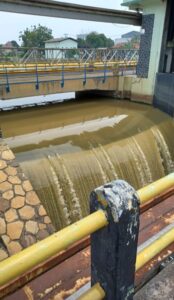
Polluted water flowing through a weir in the Bekasi River, March, 2022. Image supplied by the author.
Industrial waste management in Indonesia can be political. It is toxic and overflowing. In the case of Citarum particularly, it is also become exorbitantly expensive. Not only state expenditure, but also programs from overseas, such as the Asian Development Bank’s Integrated Citarum Water Resources Management Investment Program (ICWRMIP),attend to the pollution. Savings and Loans Cooperatives (KSP) in West Java also provide loans for wastewater management. However, the costs are not only generated from neutralising heavy metal hazard from the river, but also in cleaning up the costly bureaucracy and execution of the policy.
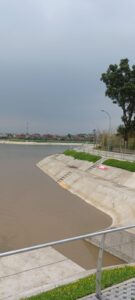
Andir Retention Pool prevents flooding in Andir, Bandung, by modifying water flow in Citarum River. May 2022. Image supplied by the author.
Fixing the “pollution” of resource misallocation begins with the planning process. Currently there are two key Citarum plan documents, one from National Planning Agency (Bappenas) and one from the Ministry of Public Works and Housing. Despite the existence of the Presidential regulation, the Citarum task force is not directly under the supervision of the president, so funding disbursement and power delegation become entwined. Operational divisions of the river should consider its natural segmentation and transboundary coordination among regions. Civil society initiatives and lawsuits, including from those who were a part of “anti-wastewater coalition,” are often ignored. Moreover, to keep the contamination level at bay by 2025 as planned, the government need to be extra vigilant in its execution. Another ambitious target is that by 2025, Citarum water can be filtered into drinking water supply. Yet, if current patterns continue and they are granted massive investment and technical assistance for such a short period of completion, the exercise will be prone to low accountability and resource capture.
All action plans have their limits. River pollution is not only a result of overwhelming waste, but a problem of resource capture across all levels of governance. However, in decentralised Indonesia, the integration of a Citarum clean-up campaign faces even broader political and administration challenges.
 Facebook
Facebook  Twitter
Twitter  Soundcloud
Soundcloud  Youtube
Youtube  Rss
Rss 